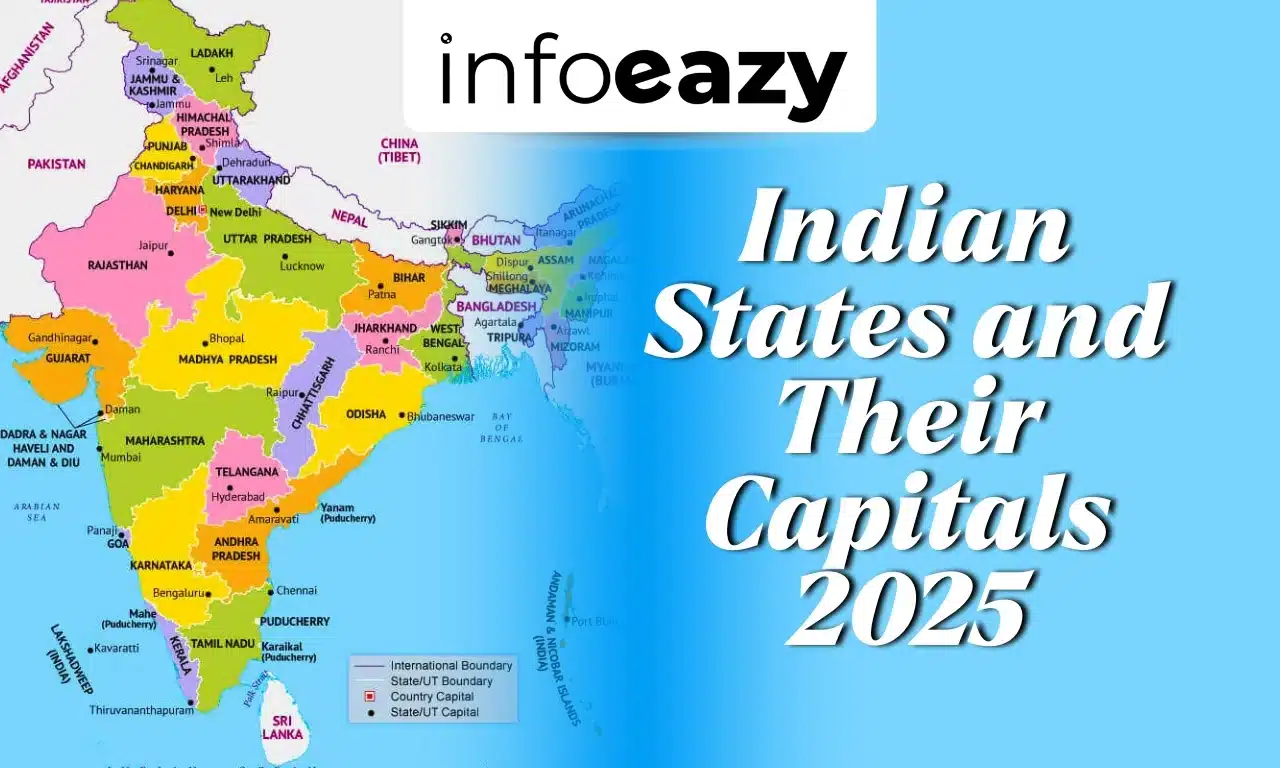India, a land of incredible diversity and unity, is composed of 28 states and 8 union territories, each having its own capital city. These capitals represent the political, administrative, and cultural heart of their respective regions. Together, they mirror the nation’s linguistic richness, historical depth, and regional identities, showcasing how India thrives as one of the world’s most dynamic federal structures.
Indian States and Their Capitals 2025
As of 2025, India has 28 states, each with its own government and capital city. These capitals are not just administrative centers; they also symbolize the heritage, economy, and spirit of the people.
| Indian States and Their Capitals 2025 | |||
| S.No. | State | Capital | Date of Formation |
| 1 | Andhra Pradesh | Amaravati | 1 November 1956 |
| 2 | Arunachal Pradesh | Itanagar | 20 February 1987 |
| 3 | Assam | Dispur | 1950 |
| 4 | Bihar | Patna | 1950 |
| 5 | Chhattisgarh | Raipur | 1 November 2000 |
| 6 | Goa | Panaji | 30 May 1987 |
| 7 | Gujarat | Gandhinagar | 1 May 1960 |
| 8 | Haryana | Chandigarh | 1 November 1966 |
| 9 | Himachal Pradesh | Shimla | 25 January 1971 |
| 10 | Jharkhand | Ranchi | 15 November 2000 |
| 11 | Karnataka | Bengaluru | 1 November 1956 |
| 12 | Kerala | Thiruvananthapuram | 1 November 1956 |
| 13 | Madhya Pradesh | Bhopal | 1 November 1956 |
| 14 | Maharashtra | Mumbai | 1 May 1960 |
| 15 | Manipur | Imphal | 21 January 1972 |
| 16 | Meghalaya | Shillong | 21 January 1972 |
| 17 | Mizoram | Aizawl | 20 February 1987 |
| 18 | Nagaland | Kohima | 1 December 1963 |
| 19 | Odisha | Bhubaneswar | 1950 |
| 20 | Punjab | Chandigarh | 1 November 1966 |
| 21 | Rajasthan | Jaipur | 30 March 1949 |
| 22 | Sikkim | Gangtok | 16 May 1975 |
| 23 | Tamil Nadu | Chennai | 1 November 1956 |
| 24 | Telangana | Hyderabad | 2 June 2014 |
| 25 | Tripura | Agartala | 21 January 1972 |
| 26 | Uttar Pradesh | Lucknow | 24 January 1950 |
| 27 | Uttarakhand | Dehradun | 9 November 2000 |
| 28 | West Bengal | Kolkata | 1950 |
Union Territories and Their Capitals 2025
The 8 Union Territories of India are directly administered by the Central Government, though some have their own legislative assemblies. Each union territory contributes to the nation’s administrative and cultural landscape in a unique way.
| Union Territories and Their Capitals 2025 | |
| Union Territory | Capital |
| Andaman and Nicobar Islands | Port Blair |
| Chandigarh | Chandigarh |
| Dadra & Nagar Haveli and Daman & Diu | Daman |
| Delhi (NCT) | New Delhi |
| Jammu and Kashmir | Srinagar (Summer), Jammu (Winter) |
| Lakshadweep | Kavaratti |
| Puducherry | Pondicherry |
| Ladakh | Leh |
Evolution of Indian States and Capitals
India’s current state structure is the result of decades of political and administrative evolution. Some of the major milestones include:
- States Reorganization Act, 1956 – Formed linguistic states and reorganized boundaries.
- Formation of Telangana (2014) – Carved out of Andhra Pradesh as India’s 29th state.
- Reorganization of Jammu & Kashmir (2019) – Split into two Union Territories: Jammu & Kashmir and Ladakh.
- Merger of Dadra & Nagar Haveli with Daman & Diu (2020) – Unified into a single Union Territory.
These reorganizations were conducted under Article 3 of the Indian Constitution, which empowers Parliament to alter state boundaries or names.
Also Read: List of Countries, Capitals, and Currencies
Difference Between States and Union Territories
Understanding how states and union territories function helps one grasp India’s governance model, especially for competitive exams like UPSC or SSC.
| Difference Between States and Union Territories | ||
| Feature | States | Union Territories |
| Administrative Head | Governor | Lieutenant Governor / Administrator |
| Governance | Elected State Government | Central Government-appointed authority |
| Powers | Shared between Centre and State | Direct control by Centre |
| Representation | Full representation in Parliament | Limited or partial representation |
Indian States and Their Official Languages
Language plays a major role in defining cultural and political identity. Each state recognizes one or more official languages that reflect the linguistic heritage of its people.
| Indian States and Their Official Languages | |
| State | Official Language(s) |
| Andhra Pradesh | Telugu |
| Arunachal Pradesh | English |
| Assam | Assamese |
| Bihar | Hindi |
| Chhattisgarh | Hindi |
| Goa | Konkani |
| Gujarat | Gujarati |
| Haryana | Hindi |
| Himachal Pradesh | Hindi |
| Jharkhand | Hindi |
| Karnataka | Kannada |
| Kerala | Malayalam |
| Madhya Pradesh | Hindi |
| Maharashtra | Marathi |
| Manipur | Meitei (Manipuri) |
| Meghalaya | English |
| Mizoram | Mizo |
| Nagaland | English |
| Odisha | Odia |
| Punjab | Punjabi |
| Rajasthan | Hindi |
| Sikkim | English, Nepali |
| Tamil Nadu | Tamil |
| Telangana | Telugu |
| Tripura | Bengali, Kokborok |
| Uttar Pradesh | Hindi |
| Uttarakhand | Hindi |
| West Bengal | Bengali |
Indian States Sharing Borders with Neighboring Countries
India shares its international boundaries with seven countries: Pakistan, China, Nepal, Bhutan, Bangladesh, Myanmar, and Afghanistan. The total land border extends over 15,200 km, making India geopolitically significant in South Asia.
States like Jammu & Kashmir, Sikkim, Arunachal Pradesh, and West Bengal hold great strategic importance as they serve as gateways to neighboring nations. Border states play a vital role in trade, security, and diplomacy.
Indian States and Their Capitals FAQs
Q1. How many states and union territories are there in India in 2025?+
Q2. Which is the largest state in India by area?+
Q3. Which is the smallest state in India by area?+
Q4. What is the capital of India?+
Q5. Which is the newest state of India?+




